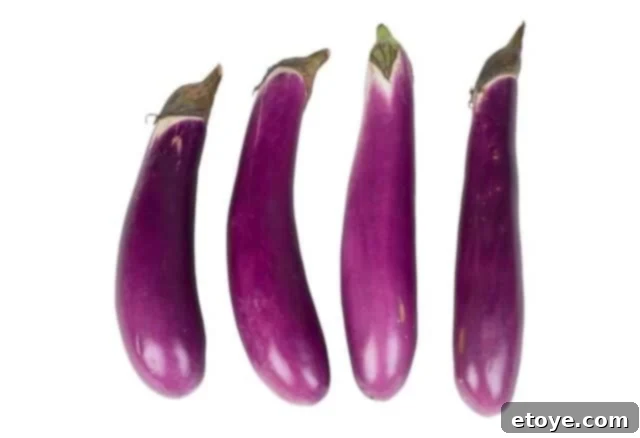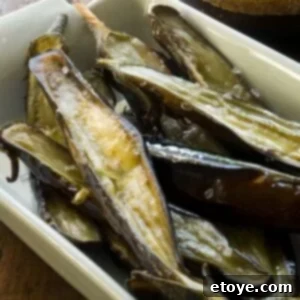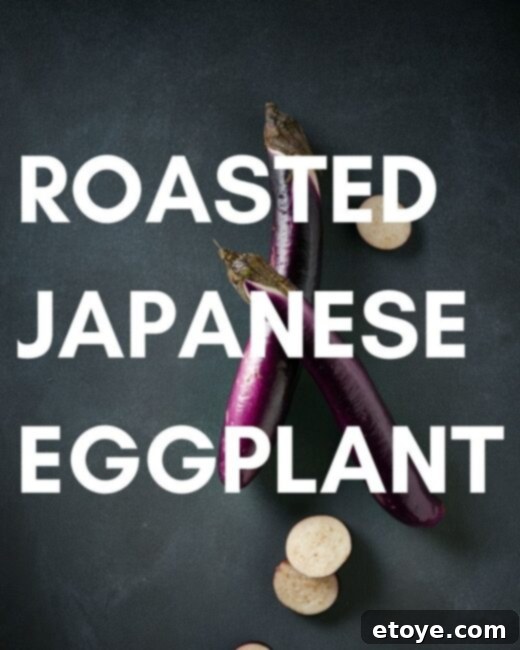Japanese eggplant, a slender and elegant cousin to the plump globe eggplant, offers a delightful culinary experience with its delicate texture and mild flavor. Unlike its robust, roly-poly counterpart, this thinner variety cooks quickly and evenly, making it an ideal choice for a speedy yet satisfying meal. Its unique characteristics allow for diverse cooking methods, from quick stir-fries to a beautifully roasted Japanese eggplant that melts in your mouth.

Mastering Roasted Japanese Eggplant: A Culinary Guide
Embark on a culinary journey to discover the exquisite versatility of Japanese eggplant. This comprehensive guide will walk you through everything you need to know about roasting this fantastic vegetable, from understanding its unique qualities to perfecting the art of oven-roasting, enhancing its natural flavors, and integrating it into delicious, healthy meals. Prepare to transform simple ingredients into a gourmet experience with minimal effort.
The Allure of Asian Eggplant: Japanese vs. Chinese vs. Globe
When it comes to eggplant, the varieties are vast, each bringing its own distinct qualities to the kitchen. While the large, dark purple globe eggplant is a common sight in many grocery stores, Asian varieties like Japanese and Chinese eggplant are gaining popularity for their superior texture, milder flavor, and quicker cooking times. Once you try them, you might just find yourself preferring these slender beauties.

What Makes Asian Eggplant Special?
Both Japanese and Chinese eggplants share several desirable characteristics that set them apart from the traditional globe eggplant. They are typically long and skinny, featuring a thin, edible skin and significantly fewer seeds. This means less bitterness and no need for the time-consuming salting process often recommended for globe eggplants. Their slender shape also contributes to a much faster cooking time, especially when roasting, making them a fantastic choice for quick weeknight dinners or Buddha bowl veggies.
Distinguishing Japanese and Chinese Eggplant
While often used interchangeably in recipes due to their similar shape and mildness, there are subtle differences between Japanese and Chinese eggplants that discerning palates may appreciate:
- Japanese Eggplant: Known for its deep, rich purple hue, almost black at times. It tends to be slightly shorter and fatter than Chinese eggplant, with a generally firmer texture when cooked. Its skin is usually quite tender, making it unnecessary to peel.
- Chinese Eggplant: Characterized by its lighter, often lavender or pale purple color. It is typically longer and more uniformly cylindrical than Japanese eggplant, with a very tender skin and creamy flesh. It cooks up incredibly soft and smooth, absorbing flavors wonderfully.

I’ve personally cultivated both varieties in my garden and can attest to their exceptional qualities, far preferring these Asian types over the larger Italian globe eggplant for most of my cooking. Their thin skin means less waste and a more enjoyable eating experience, while their quicker cooking time is a huge bonus in a busy kitchen.

Health Benefits of Eggplant
Beyond their delicious taste and culinary versatility, eggplants are a powerhouse of nutrition. They are low in calories and rich in dietary fiber, which aids in digestion and can help maintain healthy blood sugar levels. Eggplants are also packed with vitamins and minerals, including vitamin C, vitamin K, vitamin B6, thiamine, niacin, magnesium, manganese, phosphorus, copper, and folic acid. Furthermore, the vibrant color of Japanese and Chinese eggplants comes from powerful antioxidants like nasunin, which is found in the skin and has been linked to various health benefits, including protecting brain cells from damage.
Roasting Techniques: Levels of Flavor for Your Buddha Bowl Veggies
Roasting is arguably one of the best ways to prepare Japanese or Chinese eggplant, bringing out its natural sweetness and creating a wonderfully tender texture. For those who enjoy building their own customized meal bowls, often referred to as “Buddha Bowls,” mastering roasted vegetables is essential. We’ll explore different “levels” of cooking to suit your time constraints and flavor preferences.
Level One Method: Quick and Easy
This is the fastest method to cook and season your eggplant. It focuses on minimal ingredients and straightforward preparation, perfect for busy weeknights when you want healthy food on the table without fuss. Our featured roast Japanese eggplant recipe below exemplifies this method, using just oil, garlic, and salt to create a deliciously simple side dish.
Level Two Method: Enhanced Flavor
If you have a few extra minutes and want to elevate the taste, Level Two involves incorporating more aromatic ingredients and perhaps a simple marinade. Think adding a splash of soy sauce, a drizzle of sesame oil, a pinch of chili flakes, or some freshly grated ginger to your oil and garlic mixture. A short marinating time (15-30 minutes) before roasting can infuse the eggplant with deeper, more complex flavors, making it even more satisfying for your Buddha bowl veggies or as a standalone side.
Level Three Method: Gourmet Touch
For the ultimate flavor experience, Level Three might involve a more elaborate marinade, a finishing sauce, or a combination of herbs and spices that truly make the eggplant sing. Consider a miso-based glaze, a spicy peanut sauce, or a fresh herb pesto to toss the roasted eggplant in after it comes out of the oven. This method transforms the simple roasted vegetable into a star component of any meal, perfect for impressing guests or simply treating yourself to an extraordinary dish.
Recipes Using Japanese and Chinese Eggplant
These versatile eggplants shine in a variety of dishes. Here are a couple of my favorite ways to enjoy them, showcasing their incredible ability to absorb and complement bold flavors:
This first one is an absolute favorite, a classic Chinese recipe that I often adapt using fresh Japanese eggplant from my garden:
See this recipe for Chinese Eggplant with Spicy Garlic Sauce
Another fantastic dish is this unique take on stuffed eggplant, where the interior is transformed into a savory filling:
In this recipe for Stuffed Roasted Eggplant with Sausage, we carefully scoop out the tender insides of the eggplant, then mix it with flavorful sausage and re-stuff for a hearty meal.


How to Roast Japanese Eggplant: Simple and Delicious
Pin Recipe
Ingredients
- 4 Japanese or Chinese eggplants halved, lengthwise
- 2 tablespoons cooking oil
- 2 cloves garlic very finely minced
- 1/2 teaspoon salt
Instructions
- Preheat your oven to 400ºF (200ºC) to ensure it’s piping hot and ready for quick roasting. Line a baking sheet with parchment paper for easy cleanup and to prevent sticking.
- Prepare the eggplant: Take each halved eggplant and gently score the cut side a few times with a knife. This allows the flavors to penetrate deeper and helps the eggplant cook more evenly.
- In a small bowl, combine the cooking oil, finely minced garlic, and salt. Whisk these ingredients together until well mixed. Generously brush this aromatic garlicky oil mixture on the cut halves of the eggplant, ensuring each piece is well coated.
- Arrange the seasoned eggplant halves on the prepared baking sheet, cut side up. Roast for approximately 25-30 minutes, or until the eggplant is wonderfully soft and tender when pierced with a fork. The edges might be slightly caramelized and golden, adding to the flavor.
Nutrition
Tips for Perfectly Roasted Japanese Eggplant
Achieving perfectly tender and flavorful roasted eggplant is simple with a few key techniques:
- Don’t Overcrowd the Pan: Give your eggplant pieces space on the baking sheet. Overcrowding leads to steaming instead of roasting, resulting in soggy eggplant. Use two baking sheets if necessary.
- Optimal Temperature: Roasting at a higher temperature (like 400°F or 200°C) ensures the eggplant softens and slightly caramelizes on the outside without becoming watery.
- Score for Flavor: As in the recipe, scoring the cut side of the eggplant helps it absorb the oil and seasonings more effectively, enhancing the overall flavor.
- Even Coating: Ensure each piece is evenly coated with oil and seasonings. This provides a barrier that prevents drying out and promotes even browning.
- Cook Until Tender: Eggplant should be fork-tender when done. Don’t be afraid to test a piece. Overcooked eggplant can become mushy, while undercooked will be firm and less enjoyable.
Creative Serving Ideas
Roasted Japanese eggplant is incredibly versatile and can be enjoyed in numerous ways:
- Buddha Bowls: A natural fit! Combine with grains like quinoa or brown rice, other roasted vegetables, a protein source (tofu, chicken, chickpeas), and a flavorful dressing for a complete and healthy meal.
- Side Dish: Serve alongside grilled fish, roasted chicken, or a simple steak.
- Stir-fries: Add pre-roasted eggplant to a stir-fry during the last few minutes of cooking for added texture and flavor.
- Appetizer: Drizzle with a balsamic glaze, a sprinkle of fresh herbs, or a dollop of yogurt sauce for an elegant starter.
- Pasta Dishes: Toss with your favorite pasta and sauce for a light, vegetarian meal.
- Sandwiches/Wraps: Use as a flavorful filling for vegetarian sandwiches or wraps.
Storage and Reheating
Leftover roasted Japanese eggplant can be stored in an airtight container in the refrigerator for up to 3-4 days. To reheat, gently warm it in a pan on the stovetop or in the microwave. For best results, avoid over-reheating, which can make it mushy.
Conclusion: Embrace the Japanese Eggplant!
From its distinct appearance to its tender texture and mild flavor, Japanese eggplant offers a delightful alternative to its globe-shaped relatives. Roasting brings out its best qualities, making it an easy and incredibly satisfying vegetable to incorporate into your cooking. Whether you’re making a simple weeknight side or an elaborate Buddha bowl, mastering roasted Japanese eggplant is a skill that will open up a world of culinary possibilities.
If you have tried making roasted eggplant in the oven, or any other recipe on my blog, then please rate it and let me know how it turned out in the comments below!
